|
University of Liverpool
The University of Liverpool (abbreviated UOL) is a public research university in Liverpool, England. Founded in 1881 as University College Liverpool, Victoria University, it received Royal Charter by King Edward VII in 1903 attaining the decree to award degrees independently. The university withholds and operates assets on the National Heritage List, such as the Liverpool Royal Infirmary (origins in 1749), the Ness Botanic Gardens, and the Victoria Gallery & Museum. Organised into three faculties divided by 35 schools and departments, the university offers more than 230 first degree courses across 103 subjects. It is a founding member of the Russell Group, and the research intensive association of universities in Northern England, the N8 Group. The phrase "redbrick university" was inspired by the Victoria Building, thus, the university is recognised as the original redbrick university.[citation needed] Liverpool was the first UK university to establish departments in oceanography, civic design, architecture, and biochemistry (at the Johnston Laboratories), and also the first to establish an independent university campus in China, known as Xi'an Jiaotong-Liverpool University.[8][9][10][11] The university has the ninth-largest endowment of any university in the UK and in 2023/24, it had an income of £705.3 million, of which £123.3 million was from research grants and contracts, with an expenditure of £515.8 million.[5] As of 2024, the university holds four academic fellows of the Academy of Social Sciences and one of the British Academy.[12][13] Ten Nobel prize laureates have been affiliated with Liverpool as alumni or academic staff, with notable alumni leading fields in medicine, law, business, engineering, arts, politics, and technology. Graduates of the university are styled with the post-nominal letters, Lpool, to indicate the institution. HistoryUniversity College LiverpoolThe university was established in 1881 as College Liverpool, admitting its first students in 1882.[3] In 1884, it became part of the federal Victoria University. In 1894 Oliver Lodge, a professor at the university, made the world's first public radio transmission and two years later took the first surgical X-ray in the United Kingdom.[14] The Liverpool University Press was founded in 1899, making it the third-oldest university press in England. Students in this period were awarded external degrees by the University of London.[15] University status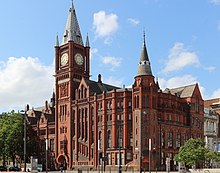  Following a royal charter and act of Parliament in 1903, it became an independent university (the University of Liverpool) with the right to confer its own degrees. The next few years saw major developments at the university, including Sir Charles Sherrington's discovery of the synapse and William Blair-Bell's work on chemotherapy in the treatment of cancer. In the 1930s to 1940s Sir James Chadwick and Sir Joseph Rotblat made major contributions to the development of the atomic bomb.[14] From 1943 to 1966 Allan Downie, Professor of Bacteriology, was involved in the eradication of smallpox. In 1994, the university was a founding member of the Russell Group, a collaboration of twenty leading research-intensive universities, as well as a founding member of the N8 Group in 2004. In the 21st century physicists, engineers and technicians from the University of Liverpool were involved in the construction of the Large Hadron Collider at CERN, working on two of the four detectors in the LHC.[16] In 2004, Sylvan Learning, later known as Laureate International Universities, became the worldwide partner for University of Liverpool online.[17] In 2019, it was announced that Kaplan Open Learning, part of Kaplan, Inc, would be the new partner for the University of Liverpool's online programmes.[18] Laureate continued to provide some teaching provision for existing students until 2021.[19] The university has produced ten Nobel Prize winners, from the fields of science, medicine, economics and peace. The Nobel laureates include the physician Sir Ronald Ross, physicist Charles Barkla, physicist Martin Lewis Perl, the physiologist Sir Charles Sherrington, physicist Sir James Chadwick, chemist Sir Robert Robinson, chemist Har Gobind Khorana, physiologist Rodney Porter, economist Ronald Coase and physicist Joseph Rotblat. Sir Ronald Ross was also the first British Nobel laureate in 1902. The university is also associated with Professors Ronald Finn and Sir Cyril Clarke who jointly won the Lasker-DeBakey Clinical Medical Research Award in 1980 and Sir David Weatherall who won the Lasker-Koshland Special Achievement Award in Medical Science in 2010. These Lasker Awards are popularly known as America's Nobels.[20] Over the 2013/2014 academic year, members of staff took part in numerous strikes after staff were offered a pay rise of 1% which unions equated to a 13% pay cut since 2008. The strikes were supported by both the university's Guild of Students and the National Union of Students.[21] Some students at the university supported the strike, occupying buildings on campus.[22] Campus and facilities   The university is mainly based around a single urban campus approximately five minutes walk from Liverpool City Centre, at the top of Brownlow Hill and Mount Pleasant. Occupying 100 acres, it contains 192 non-residential buildings that house 69 lecture theatres, 114 teaching areas, and research facilities.[citation needed] The main site is divided into three faculties: Health and Life Sciences; Humanities and Social Sciences; and Science and Engineering. The Veterinary Teaching Hospital (Leahurst) and Ness Botanical Gardens are based on the Wirral Peninsula. There was formerly a marine biology research station at Port Erin on the Isle of Man until it closed in 2006.[citation needed] Fifty-one residential buildings, on or near the campus, provide 3,385 rooms for students, on a catered or self-catering basis. The centrepiece of the campus remains the university's original red brick building, the Victoria Building. Opened in 1892, it has recently been restored as the Victoria Gallery and Museum, complete with cafe and activities for school visits.[citation needed] In 2011 the university made a commitment to invest £660m into the 'Student Experience', £250m of which will reportedly be spent on Student Accommodation. Announced so far have been two large On-Campus halls of residences (the first of which, Vine Court, opened September 2012), new Veterinary Science facilities, and a £10m refurbishment of the Liverpool Guild of Students. New Central Teaching Laboratories for physics, earth sciences, chemistry and archaeology were opened in autumn 2012.[23] In 2013, the University of Liverpool opened a satellite campus in Finsbury Square in London, offering a range of professionally focussed masters programmes.[24] Central Teaching HubThe Central Teaching Hub is a large multi-use building that houses a recently refurbished Lecture Theatre Block (LTB) and teaching facilities (Central Teaching Labs, CTL) for the Departments of Chemistry and Physics and the School of Environmental Sciences, within the university's Central City Centre Campus. It was completed and officially opened in September 2012 with an estimated project cost of £23m.[25] The main building, the 'Central Teaching Laboratory', is built around a large atrium and houses seven separate laboratories that can accommodate 1,600 students at a time. A flexible teaching space, computing centre, multi-departmental teaching spaces, and communal workspaces can also be found inside. The adjoining University Lecture Block building contains four lecture rooms and further social spaces.[26] SustainabilityIn 2008, the University of Liverpool was voted joint seventeenth greenest university in Britain by WWF supported company Green League.[27] This represents an improvement after finishing 55th in the league table the previous year.[28] The position of the university is determined by point allocation in departments such as Transport, Waste management, sustainable procurement and Emissions among other categories; these are then transpired into various awards.[29] Liverpool was awarded the highest achievement possible in Environmental policy, Environmental staff, Environmental audit, Fair trade status, Ethical investment policy and Waste recycled while also scoring points in Carbon emissions, Water recycle and Energy source.[citation needed] Liverpool was the first among UK universities to develop their desktop computer power management solution, which has been widely adopted by other institutions.[30] The university has subsequently piloted other advanced software approaches further increasing savings.[31] The university has also been at the forefront of using the Condor HTC computing platform in a power saving environment. This software, which makes use of unused computer time for computationally intensive tasks usually results in computers being left turned on.[32] The university has demonstrated an effective solution for this problem using a mixture of Wake-on-LAN and commercial power management software.[33] The Interdisciplinary Centre for Sustainability Research (ICSR) was established in 2024 to tackle the United Nations Sustainable Development Goals (SDGs).[34] Organisation and structure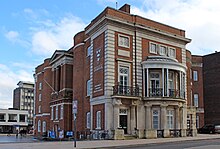 The university is a research-based university with 33,000 students pursuing over 450 programmes spanning 54 subject areas. It has a broad range of teaching and research in both arts and sciences, and the University of Liverpool School of Medicine established in 1835 is today one of the largest medical schools in the UK. It also has close links to the neighbouring Royal Liverpool University Hospital.[citation needed] The university has a students' union to represent students' interests, known as the Liverpool Guild of Students.[citation needed] The university previously had a strategic partnership with Laureate International Universities, a for-profit college collective, for University of Liverpool online degrees.[35] In 2019, the university announced a new partnership with Kaplan Open Learning for delivery of their online degrees.[18] Senior leadershipThe figurehead of the university is the chancellor. The following have served in that role:
The professional head of the university is the vice-chancellor. The following have served in that role:
FacultiesSince 2009, teaching departments of the university have been divided into three faculties: Science and Engineering, Health and Life Sciences, and Humanities and Social Sciences. Each faculty is headed by an Executive Pro-Vice-Chancellor, who is responsible for all schools in the faculty.[36]
FinancesIn the financial year ending 31 July 2024, the University of Liverpool had a total income of £705.3 million (2022/23 – £673.2 million) and total expenditure of £515.8 million (2022/23 – £662.5 million).[5] Key sources of income included £367.1 million from tuition fees and education contracts (2022/23 – £342.5 million), £93.4 million from funding body grants (2022/23 – £94.6 million), £123.3 million from research grants and contracts (2022/23 – £118 million) and £22.7 million from endowment and investment income (2022/23 – £15.6 million).[5] At year end, Liverpool had endowments of £193.8 million (2023 – £182.7 million) and total net assets of £885.6 million (2023 – £679.8 million). It holds the ninth-largest endowment of any university in the UK.[5] Academic profileAdmissions
In terms of average UCAS points of entrants, Liverpool ranked 40th in Britain in 2014.[44] The university gives offers of admission to 83.1% of its applicants, the 7th highest amongst the Russell Group.[45] According to the 2017 Times and Sunday Times Good University Guide, approximately 12% of Liverpool's undergraduates come from independent schools.[46] In the 2016–17 academic year, the university had a domicile breakdown of 72:3:25 of UK:EU:non-EU students respectively with a female to male ratio of 55:45.[47] Rankings and reputation
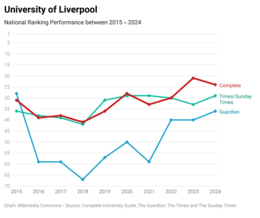 The university is ranked in the top 1% of universities worldwide according to Academic ranking of world universities and has previously been ranked within the top 150 university globally by the guide.[54] It is also a founding member of the Russell Group and a founding member of the Northern Consortium. In the Complete University Guide 2013, published in The Independent, the University of Liverpool was ranked 31st out of 124, based on nine measures,[55] while The Times Good University Guide 2008 ranked Liverpool 34th out of 113 universities.[56] The Sunday Times university guide recently ranked the University of Liverpool 27th out of 123.[57] In 2010, The Sunday Times has ranked University of Liverpool 29th of 122 institutions nationwide. In 2008 the THE-QS World University Rankings rated University of Liverpool 99th best in the world, and 137th best worldwide in 2009. In 2011 the QS World University Rankings[58] ranked the university in 123rd place, up 14. In the Times Good University Guide 2013, the University of Liverpool was ranked 29th. Liverpool is ranked 122nd in the world (and 15th in the UK) in the 2016 Round University Ranking.[59] The 2018 U.S. News & World Report ranks Liverpool 129th in the world.[60] In 2019, it ranked 178th among the universities around the world by SCImago Institutions Rankings.[61] In the 2021 Research Excellence Framework (REF), which assesses the quality of research in UK higher education institutions, Liverpool is ranked joint 25th by GPA (along with Durham University and the University of Nottingham) and 19th for research power (the grade point average score of a university, multiplied by the full-time equivalent number of researchers submitted).[62] The Research Excellence Framework for 2014 has confirmed the University of Liverpool's reputation for internationally outstanding research. Chemistry, Computer Science, General Engineering, Archaeology, Agriculture, Veterinary & Food Science, Architecture, Clinical Medicine, and English, are ranked in the top 10 in the UK for research excellence rated as 4* (world-leading) or 3* (internationally excellent), and also performed particularly well in terms of the impact of their research.[63] The Computer Science department was ranked 1st in UK for 4* and 3* research, with 97% of the research being rated as world-leading or internationally excellent – the highest proportion of any computer science department in the UK.[64] The Chemistry department was also ranked 1st in the UK with 99% of its research rated as 4* world leading or 3* internationally excellent[65] Xi'an Jiaotong-Liverpool University In 2006 the university became the first in the UK to establish an independent university in China, making it the world's first Sino-British university.[9][10][11] Resulting from a partnership between the University of Liverpool and Xi'an Jiaotong University, Xi'an Jiaotong-Liverpool University is the first Sino-British university between research-led universities, exploring new educational models for China.[66] The campus is situated in Suzhou Industrial Park in the eastern part of Suzhou in the province of Jiangsu, 90 km west of Shanghai. It is a science and engineering university with a second focus in English, recognised by the Chinese Ministry of Education as a "not-for-profit" educational institution. The university offers undergraduate degree programmes in the fields of Science, Engineering, and Management. Students are rewarded with a University of Liverpool degree as well as a degree from XJTLU. The teaching language is English. Student lifeUniversity halls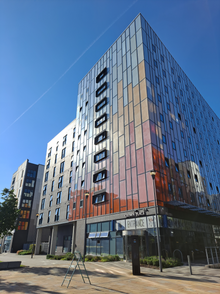 The university offers a wide selection of accommodation that are on campus as well as student villages off campus. As part of a £660 million investment in campus facilities and student experience, the university has built three new on campus halls, while refurbishing existing accommodation.[67] The accommodation offered currently by the university for 2019/2020 academic year is listed below:[citation needed]
Greenbank Student Village
In 2018, the university faced strong criticism from the student body that the university provided halls were too expensive, by the Cut the Rent campaign.[68] Privately accommodation owned Apollo Court ranked 3rd and Myrtle Court ranked 4th in the UK for value for money on a university review platform StudentCrowd.[69] In 2021 "Gladstone Halls" was renamed after leading communist and anti-racist leader Dorothy Kuya.[70] Sport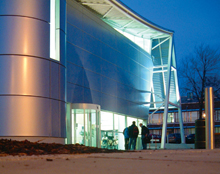 The University of Liverpool has a sporting tradition and has many premier teams in a variety of sports.[citation needed] The current sporting project comes under the title of Sport Liverpool and offers over 50 different sports ranging from football, rugby, cricket and hockey to others such as windsurfing, lacrosse, and cheerleading. Many of the sports have both male and female teams and most are involved in competition on a national level.[citation needed] BUCS is the body that organises national university competitions involving 154 institutions in 47 sports. Most sports involve travelling to various locations across the country, mainly on Wednesday afternoons. Two other prominent competitions are the Christie Championships[71] and the Varsity Cup. The Christie Cup is an inter-university competition between Liverpool, Leeds and Manchester. The Varsity Cup is a popular "derby" event between Liverpool John Moores University and the University of Liverpool. Notable alumni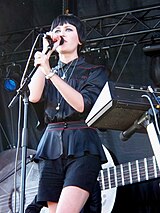  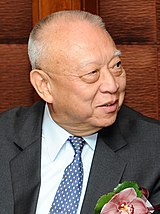
Nobel Prize winners
There have been ten Nobel Prize Laureates who have been based at the university during a significant point in their career.[74]
See also
Notes
References
Further reading
External linksWikimedia Commons has media related to University of Liverpool.
|
|||||||||||||||||||||||||||||||||||||||||||||||||||||||||||||||||||||||||||||||||||||||||||||||||||||||||||||||||||||||||||||||||||||||||||||||||||||||||||



